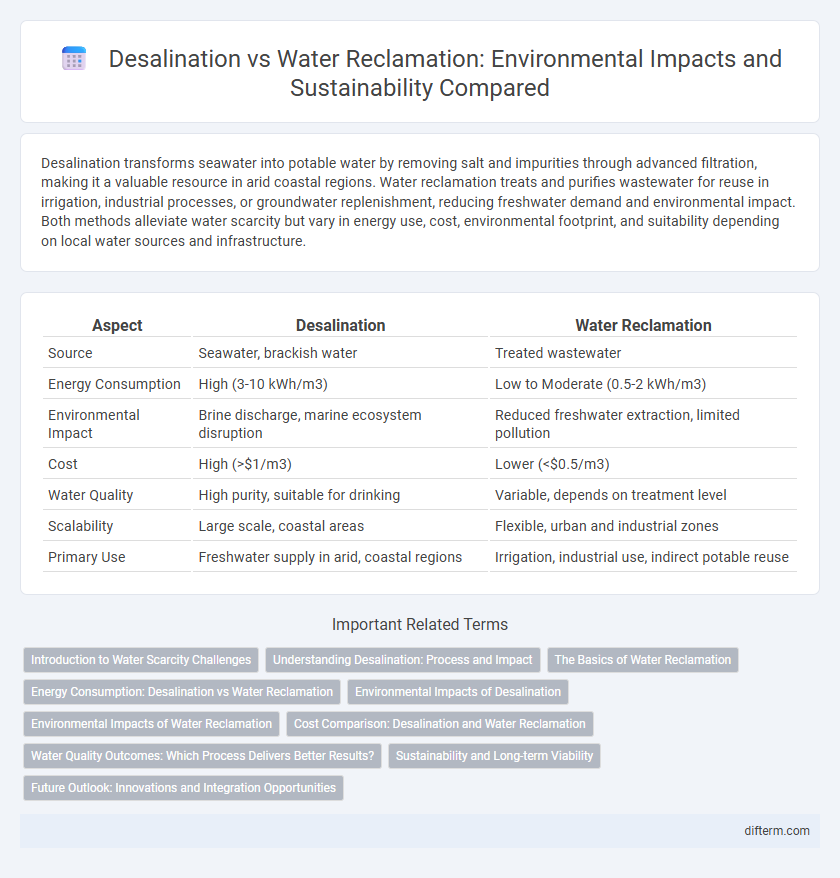Desalination transforms seawater into potable water by removing salt and impurities through advanced filtration, making it a valuable resource in arid coastal regions. Water reclamation treats and purifies wastewater for reuse in irrigation, industrial processes, or groundwater replenishment, reducing freshwater demand and environmental impact. Both methods alleviate water scarcity but vary in energy use, cost, environmental footprint, and suitability depending on local water sources and infrastructure.
Table of Comparison
| Aspect | Desalination | Water Reclamation |
|---|---|---|
| Source | Seawater, brackish water | Treated wastewater |
| Energy Consumption | High (3-10 kWh/m3) | Low to Moderate (0.5-2 kWh/m3) |
| Environmental Impact | Brine discharge, marine ecosystem disruption | Reduced freshwater extraction, limited pollution |
| Cost | High (>$1/m3) | Lower (<$0.5/m3) |
| Water Quality | High purity, suitable for drinking | Variable, depends on treatment level |
| Scalability | Large scale, coastal areas | Flexible, urban and industrial zones |
| Primary Use | Freshwater supply in arid, coastal regions | Irrigation, industrial use, indirect potable reuse |
Introduction to Water Scarcity Challenges
Water scarcity affects over 2 billion people worldwide, driving the urgent need for sustainable water sources such as desalination and water reclamation. Desalination converts seawater into potable water but demands high energy consumption and costs, while water reclamation treats wastewater to safe standards for reuse, offering a cost-effective and environmentally friendly alternative. Implementing both technologies can alleviate pressure on freshwater resources and support resilient water management in arid and drought-prone regions.
Understanding Desalination: Process and Impact
Desalination involves removing salt and minerals from seawater or brackish water through processes like reverse osmosis and thermal distillation, producing freshwater suitable for consumption and irrigation. This method addresses water scarcity but is energy-intensive and can generate brine waste, impacting marine ecosystems if not managed properly. Understanding the balance between its benefits and environmental footprint is crucial for sustainable water resource management in arid regions.
The Basics of Water Reclamation
Water reclamation involves treating wastewater to remove contaminants, enabling its reuse for irrigation, industrial processes, and groundwater recharge. This process reduces reliance on freshwater sources and helps mitigate water scarcity by recycling and purifying used water through advanced filtration and biological treatment methods. Compared to desalination, water reclamation is generally more energy-efficient and cost-effective for producing reclaimed water, especially in urban and agricultural settings.
Energy Consumption: Desalination vs Water Reclamation
Desalination processes require significantly higher energy consumption, often ranging from 3 to 10 kWh per cubic meter, compared to water reclamation which typically consumes around 0.5 to 2 kWh per cubic meter. Reverse osmosis, the most common desalination method, depends heavily on energy-intensive pumping and membrane operations, whereas water reclamation relies on biological treatment and filtration techniques that are more energy-efficient. Evaluating energy use is critical for sustainable water management, as water reclamation offers lower carbon footprints and better aligns with renewable energy integration.
Environmental Impacts of Desalination
Desalination processes often require significant energy input, leading to increased greenhouse gas emissions and contributing to climate change. The discharge of highly concentrated brine into marine environments disrupts local ecosystems by increasing salinity and temperature, which harms aquatic life and biodiversity. Additionally, the intake of seawater can cause the entrainment and impingement of marine organisms, further impacting marine habitats negatively.
Environmental Impacts of Water Reclamation
Water reclamation processes reduce the environmental footprint by minimizing the extraction of freshwater from natural sources, thereby preserving aquatic ecosystems. Treated wastewater used in agriculture and industry decreases the demand on freshwater supplies and lowers the risk of groundwater depletion. However, water reclamation may pose challenges such as potential contamination from residual pollutants and energy consumption linked to advanced treatment technologies.
Cost Comparison: Desalination and Water Reclamation
Desalination typically incurs higher operational and energy costs compared to water reclamation due to the intensive processes required to remove salt from seawater. Water reclamation leverages existing wastewater treatment infrastructure, resulting in significantly lower capital expenditures and maintenance expenses. Analyzing lifecycle costs reveals water reclamation as a more economically sustainable option for augmenting freshwater supplies in most urban settings.
Water Quality Outcomes: Which Process Delivers Better Results?
Water reclamation typically delivers superior water quality outcomes compared to desalination due to advanced treatment processes like membrane filtration, ultraviolet disinfection, and biological nutrient removal. Desalination primarily targets salt removal through reverse osmosis but may struggle with contaminants such as pharmaceuticals and organic compounds. Reclaimed water often meets or exceeds regulatory standards for potable reuse, providing reliable, high-quality water for various applications, including irrigation, industrial use, and even drinking water augmentation.
Sustainability and Long-term Viability
Desalination provides a reliable source of freshwater but often involves high energy consumption and brine discharge, posing environmental sustainability challenges. Water reclamation leverages existing wastewater streams, significantly reducing energy usage and minimizing ecological impact, enhancing long-term viability. Sustainable water management strategies increasingly prioritize reclamation due to its lower carbon footprint and resource efficiency.
Future Outlook: Innovations and Integration Opportunities
Emerging technologies in desalination, such as energy-efficient reverse osmosis and solar-powered systems, significantly reduce environmental impact and operational costs. Water reclamation advancements focus on enhanced membrane bioreactors and advanced oxidation processes to improve water quality and resource recovery. Integrating desalination with water reclamation creates sustainable urban water cycles, optimizing freshwater supply while minimizing waste and energy consumption.
Desalination vs Water reclamation Infographic

 difterm.com
difterm.com